
Feb 5, 2020 | UpstateVibe365
For the second time in four years, Due West Robotics is sending a team to the FIRST Robotics world championships, where teams from more than 70  countries will compete for the title. When I wrote about the first team in 2017, I interviewed Charles Angel, who was then the mayor of Due West, over the phone. This time, I went to Due West to meet Angel and the team, see the robot, and hear their presentations about their designs.
countries will compete for the title. When I wrote about the first team in 2017, I interviewed Charles Angel, who was then the mayor of Due West, over the phone. This time, I went to Due West to meet Angel and the team, see the robot, and hear their presentations about their designs.
The idea of the robotics program in Due West was born in 2011, when Angel’s son Ethan got a LEGO Mindstorms kit for Christmas and got hooked on robotics. That summer, Angel took Ethan and some friends to a robotics camp at Clemson, where he met a couple of FIRST Robotics coaches. They encouraged him to start a team, and even though there were naysayers who said kids from Due West (population 1,247) wouldn’t be able to compete with kids from Greenville and Columbia and Charleston, he started.
 The naysayers, needless to say, were wrong. Due West Robotics fielded a state-championship team, Tornado of Ideas, in 2017, and this year, the Spartans of TOAST team came out on top of more than 300 teams in South Carolina and will head to Houston for the world championship in April.
The naysayers, needless to say, were wrong. Due West Robotics fielded a state-championship team, Tornado of Ideas, in 2017, and this year, the Spartans of TOAST team came out on top of more than 300 teams in South Carolina and will head to Houston for the world championship in April.
Each year, FIRST Robotics announces a theme for the challenge, and this year’s theme is City Shapers. For the FIRST LEGO League teams like Spartans of TOAST, here are two pieces of the challenge: one is to design a robot that can perform a series of missions that relate to the topic. All teams receive a mat with graphics printed on it so that they are all practicing the same missions and judged on identical tasks.
The second piece is to come up with an invention that addresses a challenge related to the topic and design a prototype. The Spartans of TOAST decided to take on an outbreak of hepatitis A in the state, creating a dry hand sanitizer to kill germs that spread the disease. They call their invention the “Germ Toaster”—which led them to their team name (TOAST is also an acronym for “to obtain anything, start thinking”).
Team member Stone Driggers explained that the stainless-steel box (which does resemble a toaster oven) has motion-activated LED lights that stand in  for the germ-killing UVC lights, which will be in the working prototype. UVC lights have been used to sanitize instruments and rooms in medical settings, but their invention is unique in that it directly sanitizes the skin, Jackson Dunn told me. Team members Georgia Wojtkowski, David Clarke, and Zackery Humphrey filled in more details about the device—including the fact that the team is currently working on filing a patent on it, with guidance from physician and inventor of multiple medical devices, Dr. Jeff Deal out of Charleston, SC.
for the germ-killing UVC lights, which will be in the working prototype. UVC lights have been used to sanitize instruments and rooms in medical settings, but their invention is unique in that it directly sanitizes the skin, Jackson Dunn told me. Team members Georgia Wojtkowski, David Clarke, and Zackery Humphrey filled in more details about the device—including the fact that the team is currently working on filing a patent on it, with guidance from physician and inventor of multiple medical devices, Dr. Jeff Deal out of Charleston, SC.
After the Germ Toaster presentation, I got to see the robot—named Flower Power in honor of the late Dr. Woodie Flowers, a professor of mechanical engineering at MIT, who died in October of 2019. Flowers specialized in engineering design and product development, so it is a fitting tribute.
The robot’s performance while I was watching had some hiccups, but the team explained to me how it should have worked if all went perfectly. “So,” I asked them, “when you were at the state tournament, did it all run like clockwork?”
There was a pause, some sheepish grins, and then someone said, “That’s a firm no. We messed up a lot.”
Angel said, “This is your overcoming story, right?”
 Overcome they did. After the first round, the Spartans were in last place, and a couple of team members skipped lunch to try to work on what went wrong the robot. Before the second run, one of the team members said to Angel, “Mr. Charles, we could go from last place to first place right now!”
Overcome they did. After the first round, the Spartans were in last place, and a couple of team members skipped lunch to try to work on what went wrong the robot. Before the second run, one of the team members said to Angel, “Mr. Charles, we could go from last place to first place right now!”
They didn’t—they ended up 6th in the mission challenge. But the competition is judged on four criteria: the mission challenge, the invention, a presentation about the design of the robot to a panel of engineers, and another presentation about the team’s core values—which include things like team identity, working together, role delegation, and budgeting. The team excelled in those other three areas, which was enough to put them at the top of the competition.
And now the Spartans of TOAST will take their Germ Toaster, their Flower Power robot, their can-do attitude, and all the skills they’ve learned this year to Houston to see what they can do against teams from all over the world.
by Sharon Purvis

Jan 29, 2020 | Staying on Top, UpstateVibe365
At the invitation of Tony Brown, the executive director of Envision Williamston, I spent a couple of hours earlier this week in a town I had never visited before and didn’t know much about—Williamston, which used to be called Mineral Springs.
On the eastern edge of Anderson County, between Belton and Pelzer, sits the town of 4100 people with a familiar history—one of textile manufacturing that was once the lifeblood of the town, but now it’s more of a bedroom community for Greenville or Anderson.
It’s a town that has a lot going for it, though.
While a lot of towns talk about how to incorporate green space in their downtown areas, Williamston’s downtown is built around Mineral Spring Park. With picnic shelters, a playground, a stage, and plenty of open space, the park is used for recreation and events, and a paved path around and through the park is perfect for strollers, bicycles, wheelchairs, or walking shoes.
 Joining up with the park’s path is a paved trail that follows Big Creek to an old water treatment plant, making a mile of walking trail. A colorful mural depicting people enjoying the trail covers the side of the treatment plant building.
Joining up with the park’s path is a paved trail that follows Big Creek to an old water treatment plant, making a mile of walking trail. A colorful mural depicting people enjoying the trail covers the side of the treatment plant building.
The mineral spring for which the park (and originally the town) is named was discovered by the town’s founder, West Allen Williams, and is said to have healing powers. As word of the medicinal waters spread, a hotel was built to accommodate the people who came to the “Saratoga of the South” to seek relief for a variety of ailments. The hotel was the largest building in the state at the time, but it was destroyed by fire in 1861.
The site of that hotel is now the town’s municipal building, which previously housed several different of the town’s schools—it certainly has the feel of an old school.
But before the present building was erected in the late 1930s, another building stood on the property: The Williamston Female College, founded by Dr. Samuel Lander. That institution eventually moved to Greenwood and was renamed Lander University, and the building once more became a hotel.
College, founded by Dr. Samuel Lander. That institution eventually moved to Greenwood and was renamed Lander University, and the building once more became a hotel.
Brown envisions a lot for the town, talking enthusiastically about possibilities for a couple of abandoned buildings across from the park and how youth sports could make the difference when families are looking for a place to settle down. His vision is to draw people who are driving from Greenville to Clemson or coming to Williamson’s events not just to stop for a visit, but to see Williamston as a place to live or even to open a business.
by Sharon Purvis

Jan 16, 2020 | Staying on Top, Uncategorized, UpstateVibe365
In 1983, President Ronald Reagan signed into law a federal holiday honoring Martin Luther King, Jr., and it was observed for the first time on January 20, 1986. In  1994, Congress passed the King Holiday and Service Act, officially designating the holiday as a day of service—or, as the slogan says, “a day on, not a day off.”
1994, Congress passed the King Holiday and Service Act, officially designating the holiday as a day of service—or, as the slogan says, “a day on, not a day off.”
Across the Upstate, communities are offering opportunities for service, along with other events that honor the legacy of Martin Luther King.
Spartanburg has a lot going on, with the City of Spartanburg sponsoring a Unity Week Celebration and the United Way of the Piedmont is serving as a repository for local organizations needing volunteers for MLK Day projects—once you click the link, you’ll see more than 30 service projects that you can sign up for.
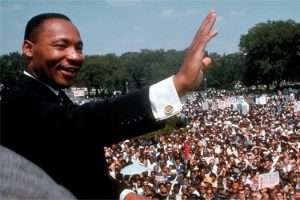 United Way of Anderson has shifted their day of celebration and service to Saturday the 18th for their Dream Day—come with a group, and you’ll be paired with a partner organization that needs volunteers. Plus all participants will get a t-shirt!
United Way of Anderson has shifted their day of celebration and service to Saturday the 18th for their Dream Day—come with a group, and you’ll be paired with a partner organization that needs volunteers. Plus all participants will get a t-shirt!
Area colleges and universities also have plenty of opportunities for students to serve, as well as programs for the community to participate in: check out the events at Furman, Clemson, Greenville Tech, Lander University, Limestone College, and Anderson University.
Check out our calendar, too, for service opportunities and other MLK celebrations!

Jan 8, 2020 | Staying on Top, Uncategorized, UpstateVibe365
It’s a new year, and here’s a resolution suggestion for you: why not explore the Upstate and find something fun to do in a county you don’t get to very often?
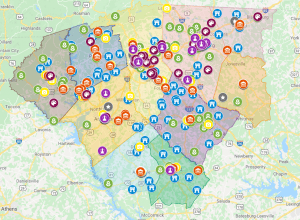
Upstate Public Art, Studios, Galleries, Gardens & Historic Sites Map
The UpstateVibe365 calendar is a great resource for events across the Upstate, but in case you haven’t scrolled down to the bottom of the newsletter in a while, we also have resource maps for arts & culture sites as well as outdoor activity and recreation (and other things too, like resources for seniors and children; schools, colleges, and universities; local government offices; and the upstate business ecosystem).
Want to see what there is to do in Abbeville or Laurens County? Zoom in on the county to see what’s there. Want to find a museum or gallery you haven’t visited before? Just uncheck the categories you don’t want to see, and the categories you do want will be left on the map, making it easy to find what you want.
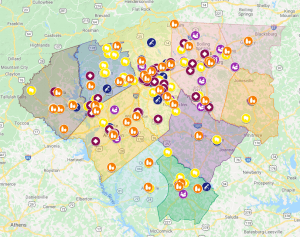
Upstate Performance Venues and Festivals
There are so many categories of arts and culture sites in the Upstate that we had to split them up into two maps! The first one contains historic sites, public art, green spaces/arboretums/gardens, gallery & exhibit spaces, museums, studios/workshops, and public landscape/fountains. The second contains indoor and outdoor performance venues, events and festivals, creative industry & cultural organizations, and farmers markets.
Some of those categories may not be what you immediately think of when you think of the arts—but taken together, they make Upstate communities more vibrant—drawing visitors, but also creating a place where people want to live. And if you think most of these places are concentrated in Greenville and Spartanburg, you may be surprised when you take a look at the maps!
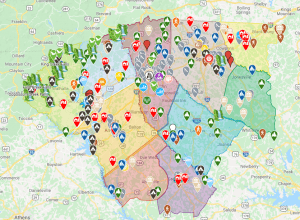
Upstate Natural Beauty and Resources Map
If getting into the great outdoors beyond a city park is more your style, the Upstate Natural Beauty and Resources Map has got you covered—with public parks, trails, historical landmarks, farms, camping sites, birding locations, lakes, rivers, waterfalls, and other recreational areas. Whatever your outdoor interest, the Upstate delivers plenty of opportunities to explore.
So choose an event from the calendar, find a point of interest you never knew was there, or visit one of the many downtowns in our ten counties. You’ll find that there truly is something happening 365 days a year in the Upstate—and don’t forget to document your Upstate adventures on Instagram, using #UpstateVibe365!

Dec 18, 2019 | UpstateVibe365

My neighbor Vince’s Christmas lights display
One of the best things about the holiday season is the Christmas lights—it almost makes it feel OK that it’s starting to get dark as I’m on my way home from work to see homes and businesses and city streets lit up with festive displays of lights. Looking out my own front window, I can see my across-the-street neighbor Vince’s front yard full of holiday lights, and it’s so cheery.
If you don’t have a Vince in your neighborhood, or if you just can’t get enough of holiday lights and want to see more, here are some places where you can go to see some impressive displays:
The Greenville Pickens Speedway Upstate Holiday Light Show has a traditional light show and one just for kids, and the whole thing lasts 30 minutes. You can either drive around the track to see everything, or park and enjoy the show, tuning your car radio to 104.3 FM for the traditional show or 92.1 FM for the kids’ show. Santa’s workshop, ice skating, and a petting zoo/pony corral are also available, so you can make an evening of it! Cost: $20 per car (additional $5 for ice skating and $10 for pictures with Santa, although there’s no charge to visit the workshop). Address: 3800 Calhoun Memorial Hwy, Easley, SC 29640
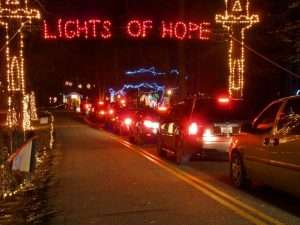
Anderson Lights of Hope
Anderson Lights of Hope has 5 miles of lights, and in addition to enjoying the light show, you can feel good about the fact that 100% of the proceeds go to benefit children and adults with disabilities in Anderson County. There is also a Santa Village, and on December 23rd, a Princess Night with Elsa. Cost: $10 per vehicle, or $20 for a bus with 15 or more passengers. Address: Old Country Farm Circle, Anderson, SC 29625
Hollywild Lights Safari is always a popular one, allowing visitors to drive through the 100-acre park to see the lights, stop by to see Santa and his animals in Santa’s village—and get a panoramic view of the lights from Mrs. Claus’s attic, and drive through the Enchanted Deer Forest for an extra $10 per vehicle and feed the animals from your car! Cost: $6 per person (children under 2 free). Address: 2325 Hampton Rd, Inman, SC
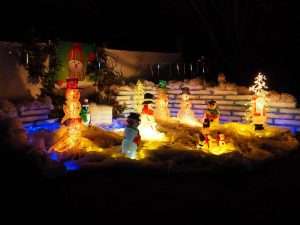
Hollywood Lights Safari
For an indoor experience, check out the holiday laser shows in the planetarium at the Roper Mountain Science Center! Choose from A Trans-Siberian Christmas or Holiday Wonderland for an unforgettable show (not recommended for children under 5). It’s advisable to purchase tickets ahead for this one and arrive early. Cost: $8 per person, or $4 for RMSC members. Address: 402 Roper Mountain Road, Greenville, SC 29615
Facebook user Jimmy Medlin alerted me to the 5M Farm Holiday Light Show in Powdersville, and Maggie Powers posted a video of a very cool lights display on our Facebook page—it’s located on Burris Road in Lyman, and the lights are on from 6:00–10:00 p.m. For a list of neighborhood displays in the Greenville area, courtesy of Greater Greenville Area Homes, click here. And there are plenty more across the upstate, which you can find at Upstate Christmas Light Shows (an interactive map of those displays can be found here).

Dec 6, 2019 | Staying on Top, UpstateVibe365
by Kayla Meadows
The city of Mauldin and the Mauldin Cultural Center are celebrating the Christmas season with a holiday market and the annual Christmas parade.
The Holiday Market will be held at the Mauldin Cultural Center (101 East Butler Road, Mauldin, SC) on December 6th from 5:00–8:00 p.m. And did I mention that it was a free event? The Mauldin Holiday Market will bring together quality local vendors offering up holiday gifts, arts, crafts, and edible goods. There will also be food trucks, from Smoke and Sweets and Mobile Meltdown.
On December 7, the Mauldin Cultural Center will be having a Christmas parade. The parade will start at 2:00 p.m., and this is also a free event. You can go and celebrate the best time of the year with the entire community. The parade will begin at Mauldin High School and it will end at the Cultural Center. There will be floats from churches, businesses, scout troops, organizations, and many more. There will also be music by the Mauldin High School Marching Band. They will be leading the one and only Santa down the parade route. And this whole event is presented by Mauldin Chamber of Commerce.
About the Mauldin Cultural Center
 Here are some more interesting facts about Mauldin Cultural Center. The Mauldin Cultural Center was built to develop a cultural system that brings joy to the Mauldin community and allows the community to have a place to meet other citizens in their community. And it gives all citizens and visitors the chance to experience and be a part of an artistic and cultural activities, and allows families and friends to bond together and get out rather than just sitting in front of a TV or playing video games. The Mauldin Cultural Center is for everyone to come and have a good time together.
Here are some more interesting facts about Mauldin Cultural Center. The Mauldin Cultural Center was built to develop a cultural system that brings joy to the Mauldin community and allows the community to have a place to meet other citizens in their community. And it gives all citizens and visitors the chance to experience and be a part of an artistic and cultural activities, and allows families and friends to bond together and get out rather than just sitting in front of a TV or playing video games. The Mauldin Cultural Center is for everyone to come and have a good time together.
In 2003, the City of Mauldin began the process of purchasing the 14 acre property as the first step toward creating a City Center. The City built the Mauldin Sports Center as the first phase. After they made the first step toward creating a City Center and making Mauldin Sports Center, they later turned the old school building into what is now the Mauldin Cultural Center. Mauldin Cultural Center also offers a wide variety of educational programming in all areas of the arts and culture and offers a variety of other cultural and arts events.
At the Mauldin Cultural Center, everyone gets to create and host their own programming if they would like, from festivals and concerts to theater and comedy. The Mauldin Cultural Council is a nonprofit organization that was founded in 2004.
You can learn more about the programs and events at the Mauldin Cultural Center here.

 countries will compete for the title. When I wrote about the first team in 2017, I interviewed Charles Angel, who was then the mayor of Due West, over the phone. This time, I went to Due West to meet Angel and the team, see the robot, and hear their presentations about their designs.
countries will compete for the title. When I wrote about the first team in 2017, I interviewed Charles Angel, who was then the mayor of Due West, over the phone. This time, I went to Due West to meet Angel and the team, see the robot, and hear their presentations about their designs. The naysayers, needless to say, were wrong. Due West Robotics fielded a state-championship team, Tornado of Ideas, in 2017, and this year, the Spartans of TOAST team came out on top of more than 300 teams in South Carolina and will head to Houston for the world championship in April.
The naysayers, needless to say, were wrong. Due West Robotics fielded a state-championship team, Tornado of Ideas, in 2017, and this year, the Spartans of TOAST team came out on top of more than 300 teams in South Carolina and will head to Houston for the world championship in April. for the germ-killing UVC lights, which will be in the working prototype. UVC lights have been used to sanitize instruments and rooms in medical settings, but their invention is unique in that it directly sanitizes the skin, Jackson Dunn told me. Team members Georgia Wojtkowski, David Clarke, and Zackery Humphrey filled in more details about the device—including the fact that the team is currently working on filing a patent on it, with guidance from physician and inventor of multiple medical devices, Dr. Jeff Deal out of Charleston, SC.
for the germ-killing UVC lights, which will be in the working prototype. UVC lights have been used to sanitize instruments and rooms in medical settings, but their invention is unique in that it directly sanitizes the skin, Jackson Dunn told me. Team members Georgia Wojtkowski, David Clarke, and Zackery Humphrey filled in more details about the device—including the fact that the team is currently working on filing a patent on it, with guidance from physician and inventor of multiple medical devices, Dr. Jeff Deal out of Charleston, SC. Overcome they did. After the first round, the Spartans were in last place, and a couple of team members skipped lunch to try to work on what went wrong the robot. Before the second run, one of the team members said to Angel, “Mr. Charles, we could go from last place to first place right now!”
Overcome they did. After the first round, the Spartans were in last place, and a couple of team members skipped lunch to try to work on what went wrong the robot. Before the second run, one of the team members said to Angel, “Mr. Charles, we could go from last place to first place right now!”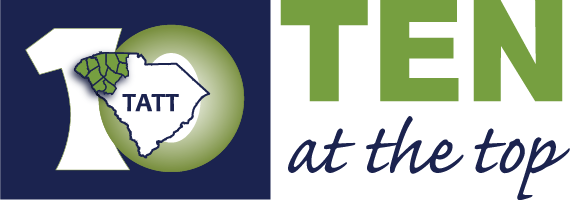

 Joining up with the park’s path is a paved trail that follows Big Creek to an old water treatment plant, making a mile of walking trail. A colorful mural depicting people enjoying the trail covers the side of the treatment plant building.
Joining up with the park’s path is a paved trail that follows Big Creek to an old water treatment plant, making a mile of walking trail. A colorful mural depicting people enjoying the trail covers the side of the treatment plant building. College, founded by Dr. Samuel Lander. That institution eventually moved to Greenwood and was renamed Lander University, and the building once more became a hotel.
College, founded by Dr. Samuel Lander. That institution eventually moved to Greenwood and was renamed Lander University, and the building once more became a hotel.
 1994, Congress passed the King Holiday and Service Act, officially designating the holiday as a day of service—or, as the slogan says, “a day on, not a day off.”
1994, Congress passed the King Holiday and Service Act, officially designating the holiday as a day of service—or, as the slogan says, “a day on, not a day off.” United Way of Anderson has shifted their day of celebration and service to Saturday the 18
United Way of Anderson has shifted their day of celebration and service to Saturday the 18








 Here are some more interesting facts about Mauldin Cultural Center. The Mauldin Cultural Center was built to develop a cultural system that brings joy to the Mauldin community and allows the community to have a place to meet other citizens in their community. And it gives all citizens and visitors the chance to experience and be a part of an artistic and cultural activities, and allows families and friends to bond together and get out rather than just sitting in front of a TV or playing video games. The Mauldin Cultural Center is for everyone to come and have a good time together.
Here are some more interesting facts about Mauldin Cultural Center. The Mauldin Cultural Center was built to develop a cultural system that brings joy to the Mauldin community and allows the community to have a place to meet other citizens in their community. And it gives all citizens and visitors the chance to experience and be a part of an artistic and cultural activities, and allows families and friends to bond together and get out rather than just sitting in front of a TV or playing video games. The Mauldin Cultural Center is for everyone to come and have a good time together.